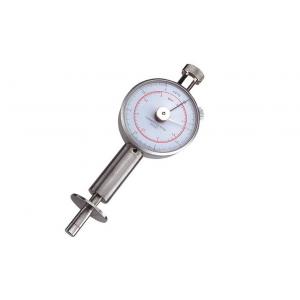

Add to Cart
Fruit hardness tester FD-1, FD-2, FD-3, use to testing apple, pear,
strawberry, grape's fruit's hardness. It is suitable for the fruit
tree scientific research department, the fruits company, the fruit
tree farm, unit and so on technical college agriculture colleges
and universities, to cultivate the improved variety the harvest
storage, the product transportation and the processing and so on by
the fruits' hardness. Thus judge fruits’ mature degree.
Application Range:
FD-1 fruit firmness tester Measures 2-15kg/cm2. Large range ideal for Apples, Peaches, Pears, Avocado, Kiwi, Tomatoes and much more. Fruit firmness one of the most accurate ways to test for a fruits maturity and quality.
FD-2 stainless steel fruit firmness tester has a measurement range
of 0.5-4kg/cm 2. The low measurement range makes it ideal for low
range fruits such as Citrus, Melons, Plums, Strawberries and other
Soft Fruits.
FD-3 stainless steel fruit firmness tester has a dual range that
allows you to measures general fruit firmness with a range of
0.5-12kg/cm2. The thinner 8mm tip is ideal for Apples, Peaches,
Pears, Avocado, Kiwis and Tomatoes. You can also change the
measurement range by swapping tips to the thicker 11mm diameter tip
and using the penetrometers dual display to a measurement range of
to 1-24kg/cm2 for tougher fruits. This this unique dual dial
display it is easy to measure the firmness of nearly all fruits.
Features:
1, Stainless steel construction.
2, Comes in a rugged stainless steel carrying case.
3, Features a trailing pointer which will indicate the highest
resistance point when testing.
4, Mountable on a test stand for lab testing.
This stainless steel fruit firmness tester has a measurement range
of 2-15kg/cm 2. The wide measurement range makes it a great general
purpose penetrometer for measuring fruits such as Apples, Peaches,
Pears, Avocado, Kiwi, Tomatoes and much more.
Fruit firmness is considered one of the most accurate ways to test
for a fruit maturity and quality. By measuring a fruits firmness
you can make decisions about when to harvest, which fruits seeds to
breed, can make decisions on which fruits to export or transport
and for example which fruits should be processed and which fruits
should be sold fresh.
Fruit Penetrometers are widely used by universities for fruit
research and by fruit companies to make important business
decisions.
Please check with your local university extension office to find
out what firmness levels are optimum for your growing climate.
Directions for use.
1, Turn the trailing dial to zero.
2, Use a potato peeler or a knife to remove the skin layer of the
fruit.
3, Position the penetrometer perpendicular to the fruit.
4, Slowly and steadily press the sensor until it penetrates the
pulp of the fruit.
5, Once the tip has penetrated the fruit pulp, read the value of
the trailing dial.
6, NOTE: measure in Kilogram-force per Square Centimeter (kg/cm2).
To convert to Pounds per Square Inch (PSI).
Technical Data:
Product Name | Analogue Fruit Hardness Tester Series | |||
Mode | FD-1 | FD-2 | FD-3 | |
Code# | 875-112 | 875-122 | 875-132 | |
Test range | 2-15kg/cm² (X10 5pa) | 0.5-4kg/cm² (X10 5pa) | 0.5-12kg/cm² (X10 5pa) | 1-24kg/cm² (X10 5pa) |
Scale | 0.1kg/cm² | 0.02kg/cm² | 0.1kg/cm² | 0.2kg/cm² |
Indenter diameter | Φ3.5mm | Φ3.5mm | Φ11.1mm | Φ7.9mm |
Accuracy | ±2% | |||
Display | Analogue display | |||
Dimension | 151×55×30mm | |||
Weight | 0.2kg | |||
Indenter depth | 10mm | |||
Principle of fruit pressure meter:
Fruit firmness is the pressure force spring bear some kind of fruit
per unit area, and their ratio is defined as the fruit firmness.
P=N/S,
(1) P is the measured fruit hardness value of 100000 Pa or kg/cm ²;
(2) N is the spring pressure of the force measuring Newton or
kilograms of force at the fruit surface;
(3) S refers to the fruit by force area square meters or square
centimeter.
Measurement by fruit pressure meter:
Before measurement: turn the dial, drive pointer and dial scale
alignment (GY-1-scale line 2, GY-2 and GY-3 type scale line 0.5);
then tested fruit cut go about 1 square centimeters of skin.
Measurement: durometer hardness meter with the hand perpendicular
to thesurface of the tested fruits, the ram uniformly pressed into
the fruit within, drives the pointer at this time to start the
drive instruction pointer rotation, when the indenter to the mark
at the stop, the hardness of the fruit in the directions indicated
by the pointer reading is taken three times average.
After measurement: rotate back to zero knob, the pointer is reset
to the initial scale.
Fruit pressure meter Precautions:
1, before the measurement should loosen the tightening knob, turn
the dial to the drive the pointer with initial scale alignment,
then tighten the fastening knob. Check indicates whether the
pointer in the right side of the driver pointer, if not, should
rotate back to zero knob so indicating pointer on the right side of
the driver pointer.
2, in order to achieve better accuracy, pressure to the pressure
head with hand before the measurement, the full scale extreme
pressure of two to three times, so that lubrication.
3, hardness measurement, should be uniform and slowly inserted not
turn the pressure into the more impact measurement.
4, the indenter and the surface of the fruit should be
perpendicular.
5, the GY-1 and GY-2 fruit hardness tester outer scale units × 10
5Pa, and the inner ring scale
units kg/cm2, GY-3 type, connected to a small pressure head, inner
ring scale readings, a large pressure
head is connected with the outer scale readings.
Fruit classification:
Types of fruit | For example |
Small fruit | Strawberries, cherry, grape, blackberry, etc |
Soft fruit | Peach, banana, apricot, plum, melon, citrus, persimmon |
Strong fruit | Pear, nectarine, kiwi fruit |
Hard fruit | Avocado |
